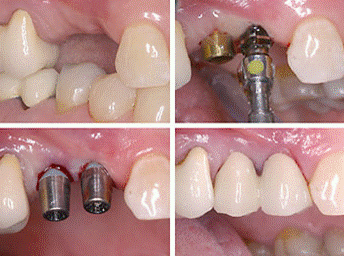

Braces, or “tooth clips” as they are more commonly called in India, is a routine treatment for a condition known in dentistry as “malocclusion,” which means your teeth are not perfectly set. This could be either because they are crowded or crooked or because your jaw is not in perfect alignment. If your lower and upper jaws do not meet properly when you close your mouth, it’s called a “bad bite.” Such tooth and jaw alignment problems could occur due to injuries, thumb-sucking in childhood or simply malformation at birth.
Dental braces are usually recommended for children while they’re growing up. Flaws in jaw structure, protruding teeth, cross bites, and other problems become apparent in children from the age of 6 onwards. If a child is given braces from the age of 8 to 14, he/she gets optimal results. This does not mean that adults can’t get braces. It’s just that cosmetic or structural dental defects can easily be corrected in growing children. These days “orthodontics,” the branch of dentistry that deals with tooth and jaw reshaping, is sufficiently advanced to treat teeth displacement and jaw irregularities at any age, given moderate bone health.
Dr. Jayanti R. Patel advises that you take kids to the dentist by age 8 if you observe uneven teeth or bad bite. For adults, he recommends braces or other orthodontic treatment to straighten out irregular jaws or to produce a nice smile. The reason to go for perfect jaw alignment is not cosmetic. A proper smile, in addition to beauty, gives you good oral health. Failing to correct crooked teeth or misaligned jaws can result in tooth decay due to food stuck in gaps between teeth, periodontal gum disease, speech impediment and chewing problems.
Modern orthodontic treatment offers a variety of options such as.
Dental Implants


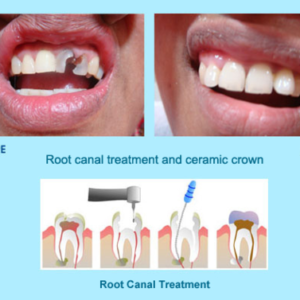 Root Canal Treatment
Root canal is the treatment in which the infected pulp is removed from the tooth and the space occupied by it is cleaned and filled with a special filling material called guttapercha. Even though the pulp has been removed from the inside of the tooth, the tooth is still embedded in a living jaw structure. The root canal tooth will not feel hot or cold. However the tooth would still retain normal sensation to touch or pressure.
Procedure
STEP 1
After the tooth is anesthetized, an opening is made through the crown into the pulp chamber.
STEP 2
The length of the root canals is determined.
STEP 3
Unhealthy pulp is removed. Canals are cleaned, enlarged and shaped.
STEP 4
Canals are filled and sealed. A metal or fibre post may be added for structural support or to retain restorative materials.
STEP 5
The tooth is sealed with a permanent filling followed by a crown adding further protection and strength to the tooth Depending on the amount of tooth structure remaining and dentist’s decision, the tooth may or may not need a post, referred as a screw by some.
Diagnosis :
The greatest diagnostic advice in this case is a digital RVG X-ray. X-ray demonstrates the presence or absence of pus accumulation in the form of a Periapical Radioluency.
Root Canal Treatment
Root canal is the treatment in which the infected pulp is removed from the tooth and the space occupied by it is cleaned and filled with a special filling material called guttapercha. Even though the pulp has been removed from the inside of the tooth, the tooth is still embedded in a living jaw structure. The root canal tooth will not feel hot or cold. However the tooth would still retain normal sensation to touch or pressure.
Procedure
STEP 1
After the tooth is anesthetized, an opening is made through the crown into the pulp chamber.
STEP 2
The length of the root canals is determined.
STEP 3
Unhealthy pulp is removed. Canals are cleaned, enlarged and shaped.
STEP 4
Canals are filled and sealed. A metal or fibre post may be added for structural support or to retain restorative materials.
STEP 5
The tooth is sealed with a permanent filling followed by a crown adding further protection and strength to the tooth Depending on the amount of tooth structure remaining and dentist’s decision, the tooth may or may not need a post, referred as a screw by some.
Diagnosis :
The greatest diagnostic advice in this case is a digital RVG X-ray. X-ray demonstrates the presence or absence of pus accumulation in the form of a Periapical Radioluency.
 Single-Sitting Root Canal Procedure.
• First a local anesthesia is administered to the tooth and the tooth become numb so that the procedure is more pleasant & comfortable.
• Next step doctor uses a drill to gain access to the area inside the tooth where the nerve is. A hole is made inside the tooth, to open the pulp chamber to allow access to the canals.
• Next, he cleans the pulp chamber and all root canals using with help of special endohandpiece instruments with use rotary files the infected nerves are removed.
• The root canals are flushed with antibacterial solution. Root canals are further cleaned scrapes and scrubs, cleaning it of debris and bacteria & reshaped to free them of all debris with the endorotary file instrument.
• Once the root canals are dry & clean, he is filled and sealed with a biocompatible material like as Gutta Purcha Points.
• The tooth cavity is then filled with a permanent tooth color light cure composite filling material.
• A root canal treated tooth should be ideally crowned after some days.
Advantage of Single visit root canal treatment
• Takes only half an hour to finish procedure thus saves time.
• A single visit procedure.
• The patient does not feel discomfort by local anesthesia again and again every visit.
• Favorable in patient who do not show up after first sitting in traditional old root canal treatment.
• This reduces the re infection chances by number of visits.
Indicationof Single visit root canal treatment
• Tooth nerve tissue has started to degenerate in case of attrition, abrasion.
• Teeth causing pain.
• Tooth nerve exposure in case of fracture or trauma to the tooth.
• Patients with acute tooth abscess.
POST AND CORE
A post and core is a dental restoration used to sufficiently build-up tooth structure for future restoration with a crown when there is not enough tooth structure to properly retain the crown, due to loss of tooth structure to either decay or fracture.
The post, commonly known as ‘screw’ is cemented in the root canal after a Root Canal Treatment (RCT) is done, in order to strengthen the tooth.
The core, such as dental composite, can be packed around the cemented post and the restored tooth is now ready for crown preparation.
Single-Sitting Root Canal Procedure.
• First a local anesthesia is administered to the tooth and the tooth become numb so that the procedure is more pleasant & comfortable.
• Next step doctor uses a drill to gain access to the area inside the tooth where the nerve is. A hole is made inside the tooth, to open the pulp chamber to allow access to the canals.
• Next, he cleans the pulp chamber and all root canals using with help of special endohandpiece instruments with use rotary files the infected nerves are removed.
• The root canals are flushed with antibacterial solution. Root canals are further cleaned scrapes and scrubs, cleaning it of debris and bacteria & reshaped to free them of all debris with the endorotary file instrument.
• Once the root canals are dry & clean, he is filled and sealed with a biocompatible material like as Gutta Purcha Points.
• The tooth cavity is then filled with a permanent tooth color light cure composite filling material.
• A root canal treated tooth should be ideally crowned after some days.
Advantage of Single visit root canal treatment
• Takes only half an hour to finish procedure thus saves time.
• A single visit procedure.
• The patient does not feel discomfort by local anesthesia again and again every visit.
• Favorable in patient who do not show up after first sitting in traditional old root canal treatment.
• This reduces the re infection chances by number of visits.
Indicationof Single visit root canal treatment
• Tooth nerve tissue has started to degenerate in case of attrition, abrasion.
• Teeth causing pain.
• Tooth nerve exposure in case of fracture or trauma to the tooth.
• Patients with acute tooth abscess.
POST AND CORE
A post and core is a dental restoration used to sufficiently build-up tooth structure for future restoration with a crown when there is not enough tooth structure to properly retain the crown, due to loss of tooth structure to either decay or fracture.
The post, commonly known as ‘screw’ is cemented in the root canal after a Root Canal Treatment (RCT) is done, in order to strengthen the tooth.
The core, such as dental composite, can be packed around the cemented post and the restored tooth is now ready for crown preparation.Root Canal Treatment

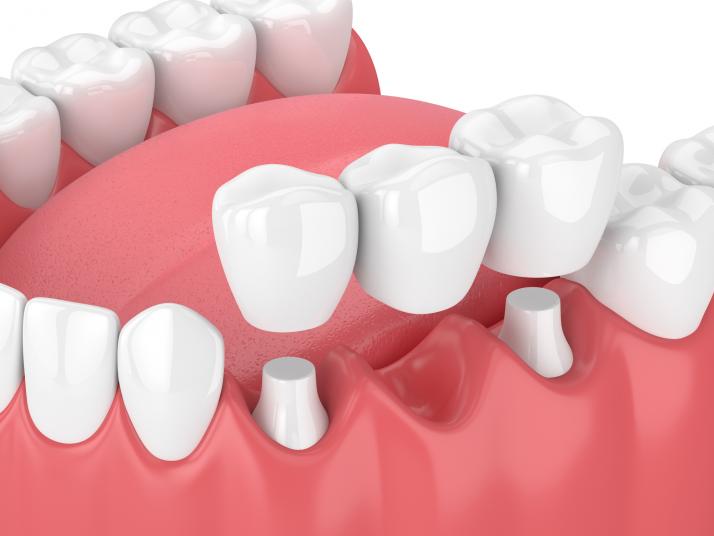
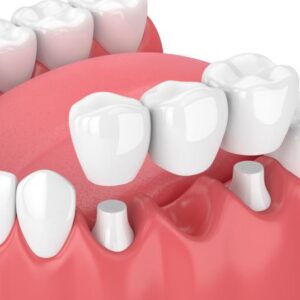 Crowns.
A crown is a dental restoration that covers or ‘caps’ a tooth to restore it to its normal shape, size and function. Its purpose is to strengthen or improve the appearance of a tooth.
Crowns.
A crown is a dental restoration that covers or ‘caps’ a tooth to restore it to its normal shape, size and function. Its purpose is to strengthen or improve the appearance of a tooth.
 Indication
1. If your tooth has undergone significant decay or a large portion has fractured such that there is not enough tooth structure remaining to provide support
2. Following root canal treatment, a crown is often needed to strengthen the tooth
3. If you have discolored or badly shaped teeth, then for cosmetic reasons and to improve the esthetics of your smile you may opt for crowns
4. Severe grinding can cause attrition and wear down the teeth to a point where only crowns can strengthen them
5. If you have a dental implant, a crown will be fitted over the implant
6. Full mouth rehabilitation may require several crowns
Bridges.
A bridge is a dental restoration that replaces or ‘bridges’ the space where one or more teeth have been lost. Bridge can be supported in many ways:
1. Through natural teeth
2. Through implants
3. Through a combination of natural teeth and implants
Indication
1. If your tooth has undergone significant decay or a large portion has fractured such that there is not enough tooth structure remaining to provide support
2. Following root canal treatment, a crown is often needed to strengthen the tooth
3. If you have discolored or badly shaped teeth, then for cosmetic reasons and to improve the esthetics of your smile you may opt for crowns
4. Severe grinding can cause attrition and wear down the teeth to a point where only crowns can strengthen them
5. If you have a dental implant, a crown will be fitted over the implant
6. Full mouth rehabilitation may require several crowns
Bridges.
A bridge is a dental restoration that replaces or ‘bridges’ the space where one or more teeth have been lost. Bridge can be supported in many ways:
1. Through natural teeth
2. Through implants
3. Through a combination of natural teeth and implants
 Important of Bridges.
1. Missing teeth may create a lasting social, psychological and emotional turbulence. Missing teeth may affect your self-esteem and confidence and may make you feel awkward, anxious and nervous or self conscious while going out in public
2. Missing teeth may affect your speech and appearance. It may cause your facial muscles to sag and give you that old worn outlook
3. Missing one or more back teeth affects chewing. The biting force on the remaining teeth begins to change to compensate for the lost tooth. Consequently there is extra pressure and discomfort which may accelerate their decay and demise
4. Teeth surrounding the missing tooth may start to shift and this leads to difficulty in cleaning and chewing. Over time there is plaque and tartar accumulation which causes gum disease and weaken the support of the remaining teeth
5. Missing teeth may lead to collapse of the jaws. This results in gaps and spaces between the remaining teeth and undue prominence of the chin, making chewing difficult and the individual looking older
Types of Crown and bridges.
Dental crowns are made up of different types of materials namely;
• Metal crown.
• Porcelain fused to metal crown (PFM).
• All ceramic crown.
• Metal free crown.
• Zirconia crown.
• CAD/CAM.
• Laser Sintered
Important of Bridges.
1. Missing teeth may create a lasting social, psychological and emotional turbulence. Missing teeth may affect your self-esteem and confidence and may make you feel awkward, anxious and nervous or self conscious while going out in public
2. Missing teeth may affect your speech and appearance. It may cause your facial muscles to sag and give you that old worn outlook
3. Missing one or more back teeth affects chewing. The biting force on the remaining teeth begins to change to compensate for the lost tooth. Consequently there is extra pressure and discomfort which may accelerate their decay and demise
4. Teeth surrounding the missing tooth may start to shift and this leads to difficulty in cleaning and chewing. Over time there is plaque and tartar accumulation which causes gum disease and weaken the support of the remaining teeth
5. Missing teeth may lead to collapse of the jaws. This results in gaps and spaces between the remaining teeth and undue prominence of the chin, making chewing difficult and the individual looking older
Types of Crown and bridges.
Dental crowns are made up of different types of materials namely;
• Metal crown.
• Porcelain fused to metal crown (PFM).
• All ceramic crown.
• Metal free crown.
• Zirconia crown.
• CAD/CAM.
• Laser SinteredCrowns and Bridges


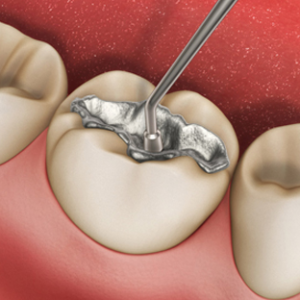 This is an overview of tooth restoration. The restorations to be described are Amalgams or silver fillings, Bonding or white fillings, Inlays and Onlays, Replacement Crowns and Veneers.
What is a dental restoration?
• A dental restoration is also called a filling. It is the repair of a damaged or decayed tooth, restoring it back to its normal shape, appearance and function.
• The name of the material that is used to repair a tooth is often the name given to the repair process. “Amalgam Restoration” is an example of the material giving its name to the process.
Why should a damaged or decayed tooth be restored?
• A tooth is repaired to protect the part of the tooth that has become exposed by the decay or injury.
• It can prevent the loss of a tooth, since decay may spread and destroy the tooth.
• Restoration permits normal eating and chewing.
• Restored teeth should reinstate, or improve upon, the appearance of teeth and the face.
What are the available dental restorations?
• There are different types of dental restorations which are used in particular situations.
Amalgam restoration
• An amalgam is an alloy or combination of two or more metals.
• Amalgam fillings (silver fillings) are made up of mercury, powdered silver and tin. They are mixed and packed into cavities in teeth. It hardens slowly, and replaces the missing tooth substance.
• Amalgam fillings are held in place by the shape of the prepared cavity.
• The cavity has to have an undercut to prevent the filling from falling out. The amalgam is then slotted into the cavity.
• It is still commonly used, despite an ongoing debate about mercury toxicity.
This is an overview of tooth restoration. The restorations to be described are Amalgams or silver fillings, Bonding or white fillings, Inlays and Onlays, Replacement Crowns and Veneers.
What is a dental restoration?
• A dental restoration is also called a filling. It is the repair of a damaged or decayed tooth, restoring it back to its normal shape, appearance and function.
• The name of the material that is used to repair a tooth is often the name given to the repair process. “Amalgam Restoration” is an example of the material giving its name to the process.
Why should a damaged or decayed tooth be restored?
• A tooth is repaired to protect the part of the tooth that has become exposed by the decay or injury.
• It can prevent the loss of a tooth, since decay may spread and destroy the tooth.
• Restoration permits normal eating and chewing.
• Restored teeth should reinstate, or improve upon, the appearance of teeth and the face.
What are the available dental restorations?
• There are different types of dental restorations which are used in particular situations.
Amalgam restoration
• An amalgam is an alloy or combination of two or more metals.
• Amalgam fillings (silver fillings) are made up of mercury, powdered silver and tin. They are mixed and packed into cavities in teeth. It hardens slowly, and replaces the missing tooth substance.
• Amalgam fillings are held in place by the shape of the prepared cavity.
• The cavity has to have an undercut to prevent the filling from falling out. The amalgam is then slotted into the cavity.
• It is still commonly used, despite an ongoing debate about mercury toxicity.
 Bonding Or Composite Restoration
“The superglue of dentistry”
• Composite resin is a plastic tooth-coloured material that is used as a filling. It is also called a white or plastic filling. The process of fusing the filling material to the tooth is called bonding.
• It is placed into the cavity in layers until the tooth is restored to its original form.
• An ultraviolet light is used to harden it, and it can be chewed on immediately after it has been completed. This is an advantage it has over amalgam.
• The filling bonds or sticks to the tooth.
• This characteristic is a major advance for dentistry. There is no longer the need to cut a slot into a tooth to hold a filling in place, as is necessary for an amalgam filling. As a result, less tooth needs to be cut away for a filling.
• We at Simplyteeth have named it “the superglue of dentistry”.
• It is hard wearing and is used for repairing front and back teeth.
• Bonding is ideal for front teeth that need cosmetic dentistry.
Bonding Or Composite Restoration
“The superglue of dentistry”
• Composite resin is a plastic tooth-coloured material that is used as a filling. It is also called a white or plastic filling. The process of fusing the filling material to the tooth is called bonding.
• It is placed into the cavity in layers until the tooth is restored to its original form.
• An ultraviolet light is used to harden it, and it can be chewed on immediately after it has been completed. This is an advantage it has over amalgam.
• The filling bonds or sticks to the tooth.
• This characteristic is a major advance for dentistry. There is no longer the need to cut a slot into a tooth to hold a filling in place, as is necessary for an amalgam filling. As a result, less tooth needs to be cut away for a filling.
• We at Simplyteeth have named it “the superglue of dentistry”.
• It is hard wearing and is used for repairing front and back teeth.
• Bonding is ideal for front teeth that need cosmetic dentistry.

Fillings/Restorations

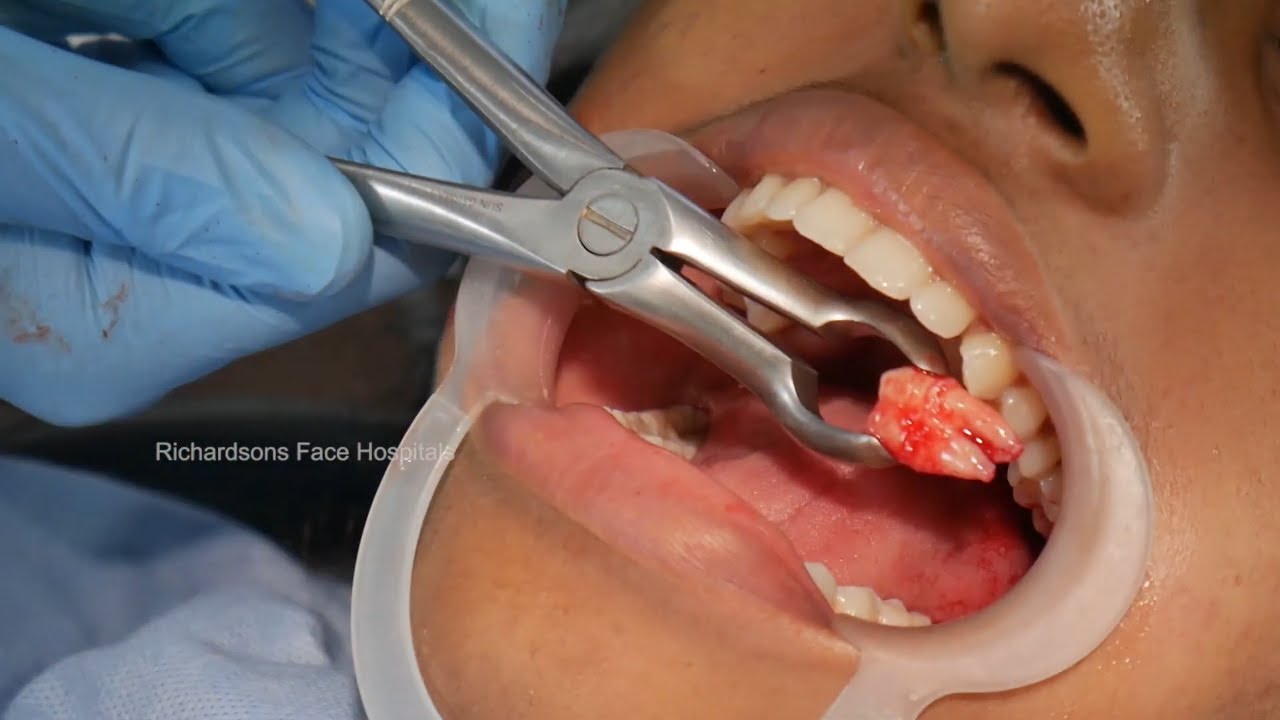
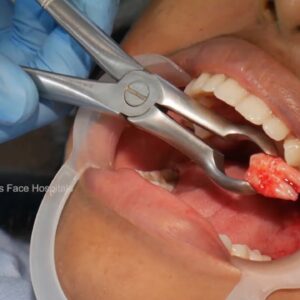 Wisdom teeth may not need to be removed if they are:
•Healthy
•Grown in completely (fully erupted)
•Positioned correctly and biting properly with their opposite teeth
•Able to be cleaned as part of daily hygiene practices
Many times, however, wisdom teeth — the third molars in the very back of your mouth — don’t have room to grow properly and can cause problems. Erupting wisdom teeth can grow at various angles in the jaw, sometimes even horizontally.
Sometimes wisdom teeth only partially emerge through the gums. Other times, they remain completely hidden. Wisdom teeth that aren’t able to emerge normally become impacted, or trapped, within your jaw.
If the wisdom teeth emerge partially through the gums, a passageway is created, which can cause problems. And because this area is hard to see and clean, it can become a magnet for bacteria that cause gum disease and oral infection.
Some dentists recommend removing wisdom teeth if they don’t fully emerge or if they grow near the nerve of the lower jaw. Many dentists believe it’s better to remove wisdom teeth before the roots are fully formed, when someone is younger and more likely to recover faster from surgery. This is why some young adults have their wisdom teeth pulled before the teeth cause problems and become more firmly rooted in the jaw.
According to the American Dental Association, wisdom teeth removal may be necessary if you experience changes in the area of those teeth, such as:
• Pain
• Repeated infection of soft tissue behind the lower last tooth
• Cysts (fluid-filled sacs)
• Tumors
• Damage to nearby teeth
• Gum disease
• Extensive tooth decay
The decision to remove wisdom teeth isn’t always clear. Talk to your dentist or an oral surgeon about the position and health of your wisdom teeth and what’s best for your situation.
Wisdom teeth may not need to be removed if they are:
•Healthy
•Grown in completely (fully erupted)
•Positioned correctly and biting properly with their opposite teeth
•Able to be cleaned as part of daily hygiene practices
Many times, however, wisdom teeth — the third molars in the very back of your mouth — don’t have room to grow properly and can cause problems. Erupting wisdom teeth can grow at various angles in the jaw, sometimes even horizontally.
Sometimes wisdom teeth only partially emerge through the gums. Other times, they remain completely hidden. Wisdom teeth that aren’t able to emerge normally become impacted, or trapped, within your jaw.
If the wisdom teeth emerge partially through the gums, a passageway is created, which can cause problems. And because this area is hard to see and clean, it can become a magnet for bacteria that cause gum disease and oral infection.
Some dentists recommend removing wisdom teeth if they don’t fully emerge or if they grow near the nerve of the lower jaw. Many dentists believe it’s better to remove wisdom teeth before the roots are fully formed, when someone is younger and more likely to recover faster from surgery. This is why some young adults have their wisdom teeth pulled before the teeth cause problems and become more firmly rooted in the jaw.
According to the American Dental Association, wisdom teeth removal may be necessary if you experience changes in the area of those teeth, such as:
• Pain
• Repeated infection of soft tissue behind the lower last tooth
• Cysts (fluid-filled sacs)
• Tumors
• Damage to nearby teeth
• Gum disease
• Extensive tooth decay
The decision to remove wisdom teeth isn’t always clear. Talk to your dentist or an oral surgeon about the position and health of your wisdom teeth and what’s best for your situation.

 Impacted wisdom teeth fall into one of several categories:
– Mesioangular impaction is the most common form (44%), and means the tooth is angled forward, towards the front of the mouth.
– Vertical impaction (38%) occurs when the formed tooth does not erupt fully through the gum line.
– Distoangular impaction (6%) means the tooth is angled backward, towards the rear of the mouth.
– Horizontal impaction (3%) is the least common form, which occurs when the tooth is angled fully ninety degrees sideways, growing into the roots of the second molar.
Impacted wisdom teeth fall into one of several categories:
– Mesioangular impaction is the most common form (44%), and means the tooth is angled forward, towards the front of the mouth.
– Vertical impaction (38%) occurs when the formed tooth does not erupt fully through the gum line.
– Distoangular impaction (6%) means the tooth is angled backward, towards the rear of the mouth.
– Horizontal impaction (3%) is the least common form, which occurs when the tooth is angled fully ninety degrees sideways, growing into the roots of the second molar.Wisdom Tooth Removal

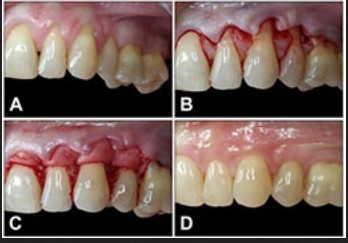
 In cases of advanced gum disease, where non-surgical therapy doesn’t work for improvement of your gums health, surgical therapy is considered. Different procedures included in surgical therapy are:
Flap surgery/pocket reduction surgery:
During this procedure the gums are lifted back and the tarter is removed.
Bone grafts:
Involves using fragments of your own bone, synthetic bone, or donated bone to replace bone destroyed by gum disease.
Soft tissue grafts:
This procedure reinforces thin gums or fills in places where gums have receded.
Guided tissue regeneration:
Done in combination with flap surgery, a small piece of mesh-like fabric is inserted between the bone and gum tissue.
Bone surgery:
Smoothes shallow craters in the bone due to moderate and advanced bone loss.
SPLINTING OF TEETH
What is splinting of teeth?
In some cases, loose teeth are good candidates for a procedure known as “splinting”. When teeth are splinted, they are joined together to increase their strength.
For example, the teeth on the bottom jaw in the front of the mouth are common targets for gum disease. If two or three of those teeth become loose, they can be joined to surrounding teeth that are more stable.
One common technique is placing a wire across the loosened tooth and bonding with dental composite material. Once the teeth are splinted, they are much more stable, and eating can become comfortable again.
In cases of advanced gum disease, where non-surgical therapy doesn’t work for improvement of your gums health, surgical therapy is considered. Different procedures included in surgical therapy are:
Flap surgery/pocket reduction surgery:
During this procedure the gums are lifted back and the tarter is removed.
Bone grafts:
Involves using fragments of your own bone, synthetic bone, or donated bone to replace bone destroyed by gum disease.
Soft tissue grafts:
This procedure reinforces thin gums or fills in places where gums have receded.
Guided tissue regeneration:
Done in combination with flap surgery, a small piece of mesh-like fabric is inserted between the bone and gum tissue.
Bone surgery:
Smoothes shallow craters in the bone due to moderate and advanced bone loss.
SPLINTING OF TEETH
What is splinting of teeth?
In some cases, loose teeth are good candidates for a procedure known as “splinting”. When teeth are splinted, they are joined together to increase their strength.
For example, the teeth on the bottom jaw in the front of the mouth are common targets for gum disease. If two or three of those teeth become loose, they can be joined to surrounding teeth that are more stable.
One common technique is placing a wire across the loosened tooth and bonding with dental composite material. Once the teeth are splinted, they are much more stable, and eating can become comfortable again.Gum Surgery Treatment

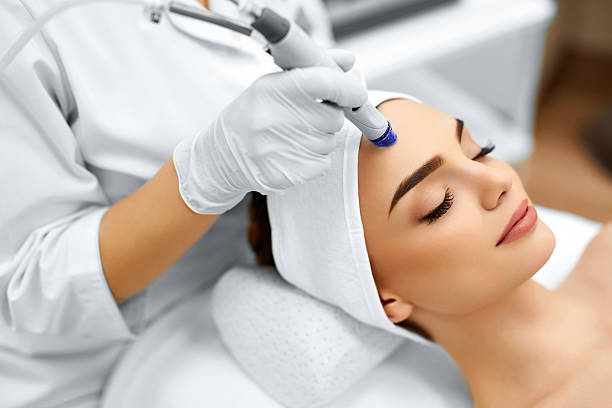
 What are facial aesthetics treatments?
The natural ageing process, lifestyle and the environment contribute to unwanted facial lines, wrinkles and uneven skin tones.
Facial aesthetics is the term we use to describe the range of non-surgical treatments our practice offers to temporarily soften expression lines and define certain facial features and contours, facial aesthetics are known and described in many forms e.g. Botox, fillers, anti-wrinkle injections etc.
What does facial aesthetics consist of?
At St Raphael’s Dental Practice we are able to offer a range of treatment options that have proven to be both safe and effective, this includes injections to temporarily soften the appearance of frown lines and crow’s feet.
Other options include dermal fillers designed to increase the volume and improve the appearance of the skin, fillers can be used to temporally improve the definition of certain facial features including lips, cheek and chin.
How can I ensure facial aesthetic treatment is safe?
The most important aspect for patients when considering facial ascetics treatment is ensuring the practitioner is both suitably qualified and experienced. Consider also using practitioner who works from a clean and safe environment who provide a reputable service e.g. a health care establishment.
At St Raphael’s Dental Practice we have worked hard to build up a reputation of being a caring patient focused practice providing dental care and facial aesthetics in a safe and clean environment.
Our facial aesthetics practitioner Dr Jasmine Tirani has worked in dentistry and provided facial aesthetics for many years and prides herself on giving confidence back to her patients.
What are facial aesthetics treatments?
The natural ageing process, lifestyle and the environment contribute to unwanted facial lines, wrinkles and uneven skin tones.
Facial aesthetics is the term we use to describe the range of non-surgical treatments our practice offers to temporarily soften expression lines and define certain facial features and contours, facial aesthetics are known and described in many forms e.g. Botox, fillers, anti-wrinkle injections etc.
What does facial aesthetics consist of?
At St Raphael’s Dental Practice we are able to offer a range of treatment options that have proven to be both safe and effective, this includes injections to temporarily soften the appearance of frown lines and crow’s feet.
Other options include dermal fillers designed to increase the volume and improve the appearance of the skin, fillers can be used to temporally improve the definition of certain facial features including lips, cheek and chin.
How can I ensure facial aesthetic treatment is safe?
The most important aspect for patients when considering facial ascetics treatment is ensuring the practitioner is both suitably qualified and experienced. Consider also using practitioner who works from a clean and safe environment who provide a reputable service e.g. a health care establishment.
At St Raphael’s Dental Practice we have worked hard to build up a reputation of being a caring patient focused practice providing dental care and facial aesthetics in a safe and clean environment.
Our facial aesthetics practitioner Dr Jasmine Tirani has worked in dentistry and provided facial aesthetics for many years and prides herself on giving confidence back to her patients.Facial Asthetics


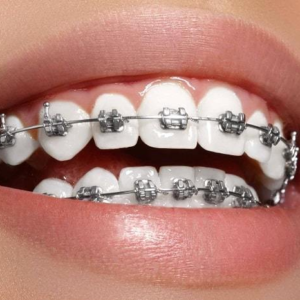 Braces, or “tooth clips” as they are more commonly called in India, is a routine treatment for a condition known in dentistry as “malocclusion,” which means your teeth are not perfectly set. This could be either because they are crowded or crooked or because your jaw is not in perfect alignment. If your lower and upper jaws do not meet properly when you close your mouth, it’s called a “bad bite.” Such tooth and jaw alignment problems could occur due to injuries, thumb-sucking in childhood or simply malformation at birth.
Dental braces are usually recommended for children while they’re growing up. Flaws in jaw structure, protruding teeth, cross bites, and other problems become apparent in children from the age of 6 onwards. If a child is given braces from the age of 8 to 14, he/she gets optimal results. This does not mean that adults can’t get braces. It’s just that cosmetic or structural dental defects can easily be corrected in growing children. These days “orthodontics,” the branch of dentistry that deals with tooth and jaw reshaping, is sufficiently advanced to treat teeth displacement and jaw irregularities at any age, given moderate bone health.
Dr. Jayanti R. Patel advises that you take kids to the dentist by age 8 if you observe uneven teeth or bad bite. For adults, he recommends braces or other orthodontic treatment to straighten out irregular jaws or to produce a nice smile. The reason to go for perfect jaw alignment is not cosmetic. A proper smile, in addition to beauty, gives you good oral health. Failing to correct crooked teeth or misaligned jaws can result in tooth decay due to food stuck in gaps between teeth, periodontal gum disease, speech impediment and chewing problems.
Braces, or “tooth clips” as they are more commonly called in India, is a routine treatment for a condition known in dentistry as “malocclusion,” which means your teeth are not perfectly set. This could be either because they are crowded or crooked or because your jaw is not in perfect alignment. If your lower and upper jaws do not meet properly when you close your mouth, it’s called a “bad bite.” Such tooth and jaw alignment problems could occur due to injuries, thumb-sucking in childhood or simply malformation at birth.
Dental braces are usually recommended for children while they’re growing up. Flaws in jaw structure, protruding teeth, cross bites, and other problems become apparent in children from the age of 6 onwards. If a child is given braces from the age of 8 to 14, he/she gets optimal results. This does not mean that adults can’t get braces. It’s just that cosmetic or structural dental defects can easily be corrected in growing children. These days “orthodontics,” the branch of dentistry that deals with tooth and jaw reshaping, is sufficiently advanced to treat teeth displacement and jaw irregularities at any age, given moderate bone health.
Dr. Jayanti R. Patel advises that you take kids to the dentist by age 8 if you observe uneven teeth or bad bite. For adults, he recommends braces or other orthodontic treatment to straighten out irregular jaws or to produce a nice smile. The reason to go for perfect jaw alignment is not cosmetic. A proper smile, in addition to beauty, gives you good oral health. Failing to correct crooked teeth or misaligned jaws can result in tooth decay due to food stuck in gaps between teeth, periodontal gum disease, speech impediment and chewing problems.Braces

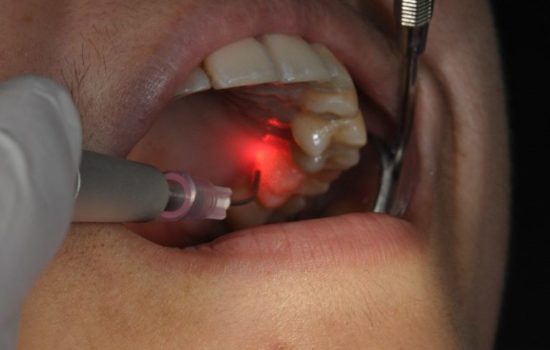
 Benefits of Laser Dentistry
• Painless.
• Less time in dental chair for dental treatment.
• No whining sound associated with the dental drill.
• Absolutely Painless Procedure.
• During Surgery less bleeding.
• Suture-less surgical producer possible.
• More comfortable for kids and young adults.
• Reduce Swelling.
• Less chance of postoperative infection.
• During Surgery Minimum damaged surrounding and adjacent tissues.
• Increase effect of tooth whitening without any side effect.
• No Consumption of harmful chemicals.
• Quick removal of tooth decay/dental caries. Long lasting fillings.
• Faster healing process.
• Preservation of tooth and surrounding structure.
• Dental laser’s ability to kill bacteria so create a more sterilized environment.
Important uses of lasers in Dentistry
There are several uses of Laser in dentistry for hard tissue and for a soft tissue.
Laser uses of dental Hard Tissue Tooth.
• Conservative Decay removal /Cavity Removal
• Removal of tooth structure or lesions to eliminate disease
• Dental Implant
Laser uses of dental Soft Tissue / Periodontium.
• Laser Depigmentation
• Smile design/ gum reshaping / Gumline contouring
• Gum lift / Crown lengthening
• Periodontal / gum related care
Special painless uses of Laser in oral dentistry.
• Laser Teeth Whitening
• Single sitting Root canal treatment
• Frenectomy and tongue tie
• Curing of restorative filling materials
• Cosmetic enhancements
• Lip Repositioning
• Minor gum surgery / Soft tissue surgical procedures
• Leukoplakia
• Lichen planus
• Cold Sore/Ulcer
• Epulis.
• Canker sore and herpes lesions – laser can reduce pain / itching of sores.
Benefits of Laser Dentistry
• Painless.
• Less time in dental chair for dental treatment.
• No whining sound associated with the dental drill.
• Absolutely Painless Procedure.
• During Surgery less bleeding.
• Suture-less surgical producer possible.
• More comfortable for kids and young adults.
• Reduce Swelling.
• Less chance of postoperative infection.
• During Surgery Minimum damaged surrounding and adjacent tissues.
• Increase effect of tooth whitening without any side effect.
• No Consumption of harmful chemicals.
• Quick removal of tooth decay/dental caries. Long lasting fillings.
• Faster healing process.
• Preservation of tooth and surrounding structure.
• Dental laser’s ability to kill bacteria so create a more sterilized environment.
Important uses of lasers in Dentistry
There are several uses of Laser in dentistry for hard tissue and for a soft tissue.
Laser uses of dental Hard Tissue Tooth.
• Conservative Decay removal /Cavity Removal
• Removal of tooth structure or lesions to eliminate disease
• Dental Implant
Laser uses of dental Soft Tissue / Periodontium.
• Laser Depigmentation
• Smile design/ gum reshaping / Gumline contouring
• Gum lift / Crown lengthening
• Periodontal / gum related care
Special painless uses of Laser in oral dentistry.
• Laser Teeth Whitening
• Single sitting Root canal treatment
• Frenectomy and tongue tie
• Curing of restorative filling materials
• Cosmetic enhancements
• Lip Repositioning
• Minor gum surgery / Soft tissue surgical procedures
• Leukoplakia
• Lichen planus
• Cold Sore/Ulcer
• Epulis.
• Canker sore and herpes lesions – laser can reduce pain / itching of sores.
Lasers In Dentistry


 “TEETHING” Around 6 months of age, your baby’s first shiny white tooth will usually appear, typically in the front center of the lower jaw. This eruption of primary teeth / baby teeth is called teething.
Minor discomfort is associated with teething, and some of the symptoms you will see include irritability, sore or inflamed gums, excessive drooling of saliva, loss of appetite, a change in eating habits or difficulty in sleeping. These should not cause alarm and are to be expected. However, if your baby experiences other problems during the teething process such as rash, fever or vomiting, something else may be wrong. Consult with your pediatrician in those cases, and do not make the assumption it is due to teething. The best thing to do to aid discomfort is to clean your baby’s mouth with a damp gauze pad two or three times daily, and giving your baby a teething ring to chew on.
WHAT PARENTS CAN DO TO PREVENT BABY BOTTLE TOOTH DECAY
You can prevent this from happening to your child’s teeth by learning how to protect them.
– Clean your child’s teeth daily
– Never allow your child to fall asleep with a bottle filled with juice, milk, or infant formula (or when awake, sip on it for long periods of time as a pacifier)
– Start bottle weaning by at least a year
– Give your child plain water for thirst
– Make sure your child gets the fluoride needed to prevent decay
– Have regular dental visits for your child beginning when their first tooth erupts
PIT AND FISSURE SEALANTS TO PREVENT CAVITY
Sealants are a safe and painless way of protecting your children’s teeth from decay. A sealant is a protective plastic resin coating (similar to a tooth colored filling), which is applied to the biting surfaces of the back teeth. The sealant forms a hard shield that keeps food and bacteria from getting into the tiny grooves in the teeth and causing decay.
“TEETHING” Around 6 months of age, your baby’s first shiny white tooth will usually appear, typically in the front center of the lower jaw. This eruption of primary teeth / baby teeth is called teething.
Minor discomfort is associated with teething, and some of the symptoms you will see include irritability, sore or inflamed gums, excessive drooling of saliva, loss of appetite, a change in eating habits or difficulty in sleeping. These should not cause alarm and are to be expected. However, if your baby experiences other problems during the teething process such as rash, fever or vomiting, something else may be wrong. Consult with your pediatrician in those cases, and do not make the assumption it is due to teething. The best thing to do to aid discomfort is to clean your baby’s mouth with a damp gauze pad two or three times daily, and giving your baby a teething ring to chew on.
WHAT PARENTS CAN DO TO PREVENT BABY BOTTLE TOOTH DECAY
You can prevent this from happening to your child’s teeth by learning how to protect them.
– Clean your child’s teeth daily
– Never allow your child to fall asleep with a bottle filled with juice, milk, or infant formula (or when awake, sip on it for long periods of time as a pacifier)
– Start bottle weaning by at least a year
– Give your child plain water for thirst
– Make sure your child gets the fluoride needed to prevent decay
– Have regular dental visits for your child beginning when their first tooth erupts
PIT AND FISSURE SEALANTS TO PREVENT CAVITY
Sealants are a safe and painless way of protecting your children’s teeth from decay. A sealant is a protective plastic resin coating (similar to a tooth colored filling), which is applied to the biting surfaces of the back teeth. The sealant forms a hard shield that keeps food and bacteria from getting into the tiny grooves in the teeth and causing decay.
 Indications.
Sealants are only applied to the back teeth – the molars and premolars. These are the teeth that have pits and fissures on their biting surfaces. Your dentist will tell you which teeth should be sealed after he/she has examined them, and checked whether the fissures are deep enough for sealing to help. Some teeth naturally form with deep grooves which will need to be sealed, others with shallow ones which will not need sealing.
Prosiger.
The process is usually quick and straightforward taking only a few minutes per tooth. The tooth is thoroughly cleaned, prepared with a special solution, and dried. The liquid sealant is then applied and allowed to set hard – usually by shining an ultraviolet light onto it.
Indications.
Sealants are only applied to the back teeth – the molars and premolars. These are the teeth that have pits and fissures on their biting surfaces. Your dentist will tell you which teeth should be sealed after he/she has examined them, and checked whether the fissures are deep enough for sealing to help. Some teeth naturally form with deep grooves which will need to be sealed, others with shallow ones which will not need sealing.
Prosiger.
The process is usually quick and straightforward taking only a few minutes per tooth. The tooth is thoroughly cleaned, prepared with a special solution, and dried. The liquid sealant is then applied and allowed to set hard – usually by shining an ultraviolet light onto it.
 Durability.
Sealants usually last for many years, but your dentist will want to check them regularly to make sure that the seal is still intact. They can wear over time, and sometimes the dentist needs to add or replace some sealant to be sure that no decay can start underneath them.
Mekanism.
The sealant forms a smooth, protective barrier, by covering all the little grooves and dips in the surface of the tooth. Dental decay easily starts in these grooves.
Proper Age.
Sealants are often applied as soon as the permanent teeth start to come through. This is usually between 6 and 7 years of age for the first molar teeth. The rest are usually sealed as soon as they appear which can be any time between 11 and 14 years of age (premolars).
Durability.
Sealants usually last for many years, but your dentist will want to check them regularly to make sure that the seal is still intact. They can wear over time, and sometimes the dentist needs to add or replace some sealant to be sure that no decay can start underneath them.
Mekanism.
The sealant forms a smooth, protective barrier, by covering all the little grooves and dips in the surface of the tooth. Dental decay easily starts in these grooves.
Proper Age.
Sealants are often applied as soon as the permanent teeth start to come through. This is usually between 6 and 7 years of age for the first molar teeth. The rest are usually sealed as soon as they appear which can be any time between 11 and 14 years of age (premolars).
 FLOURIDE TREATMENT
Topical Fluoride.
Topical fluoride is a preventive agent applied to tooth enamel. It comes in a number of different forms. A dental professional places gels or foams in trays that are held against the teeth for up to four minutes. Fluoride varnish is brushed or “painted” on the enamel.
→ Varnish is especially useful for young patients and those with special needs who may not tolerate fluoride trays. Children who benefit the most from fluoride are those at highest risk for decay. “Indicated” for Patients having a history of previous cavities, a diet high in sugar or carbohydrates, orthodontic appliances, and certain medical conditions such as dry mouth.
Need For Fluoride Supplements.
Fluoride inhibits loss of minerals from tooth enamel and encourages remineralization (strengthening areas that are weakened and beginning to develop cavities). Fluoride also affects bacteria that cause cavities, discouraging Acid Attacks that break down the tooth. Risk for decay is reduced even more when fluoride is combined with a healthy diet and good oral hygiene.
Appropriate Age For Fluoride Supplements.
The dentist considers many factors before recommending a fluoride supplement. Your child’s age, risk of developing dental decay and dietary sources of fluoride are important considerations. Infant formulas contain different amounts of fluoride. Bottled, filtered and well waters also vary in the amount of fluoride they contain. Your dentist can help determine if your child is receiving — and not exceeding — the recommended amount.
Mode of Action.
In general, kids under the age of 6 months do not need fluoride supplements. Fluoridation is done to prevent cavity formation in milk teeth. Proper oral hygiene maintenance from the start will prevent cavities in permanent teeth provided you follow your dentist’s instructions. Fluoride treatment is recommended for a child above 3 years of age.
FLOURIDE TREATMENT
Topical Fluoride.
Topical fluoride is a preventive agent applied to tooth enamel. It comes in a number of different forms. A dental professional places gels or foams in trays that are held against the teeth for up to four minutes. Fluoride varnish is brushed or “painted” on the enamel.
→ Varnish is especially useful for young patients and those with special needs who may not tolerate fluoride trays. Children who benefit the most from fluoride are those at highest risk for decay. “Indicated” for Patients having a history of previous cavities, a diet high in sugar or carbohydrates, orthodontic appliances, and certain medical conditions such as dry mouth.
Need For Fluoride Supplements.
Fluoride inhibits loss of minerals from tooth enamel and encourages remineralization (strengthening areas that are weakened and beginning to develop cavities). Fluoride also affects bacteria that cause cavities, discouraging Acid Attacks that break down the tooth. Risk for decay is reduced even more when fluoride is combined with a healthy diet and good oral hygiene.
Appropriate Age For Fluoride Supplements.
The dentist considers many factors before recommending a fluoride supplement. Your child’s age, risk of developing dental decay and dietary sources of fluoride are important considerations. Infant formulas contain different amounts of fluoride. Bottled, filtered and well waters also vary in the amount of fluoride they contain. Your dentist can help determine if your child is receiving — and not exceeding — the recommended amount.
Mode of Action.
In general, kids under the age of 6 months do not need fluoride supplements. Fluoridation is done to prevent cavity formation in milk teeth. Proper oral hygiene maintenance from the start will prevent cavities in permanent teeth provided you follow your dentist’s instructions. Fluoride treatment is recommended for a child above 3 years of age.Child Dental Care
